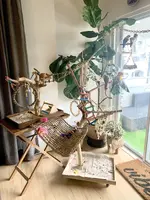Cosmographer
New member
Hello all,
I've been searching for the toxicity of wood to birds, but have been encountering difficulty in finding anything conclusive on wood mostly commonly found in my region. Specifically:
Santol (aka Cotton Fruit tree [Sandoricum koetjape])
Dao (aka New Guinea walnut [Dracontomelon dao])
Meranti (aka Philippine mahogany [Shorea genus])
Kakawate (aka Madre de Cacao [Gliricidia sepium])
Kalachuchi (aka Temple Flower[Plumeria acuminata])
Does anyone happen to know the safety of these woods?
I've been searching for the toxicity of wood to birds, but have been encountering difficulty in finding anything conclusive on wood mostly commonly found in my region. Specifically:
Santol (aka Cotton Fruit tree [Sandoricum koetjape])
Dao (aka New Guinea walnut [Dracontomelon dao])
Meranti (aka Philippine mahogany [Shorea genus])
Kakawate (aka Madre de Cacao [Gliricidia sepium])
Kalachuchi (aka Temple Flower[Plumeria acuminata])
Does anyone happen to know the safety of these woods?

